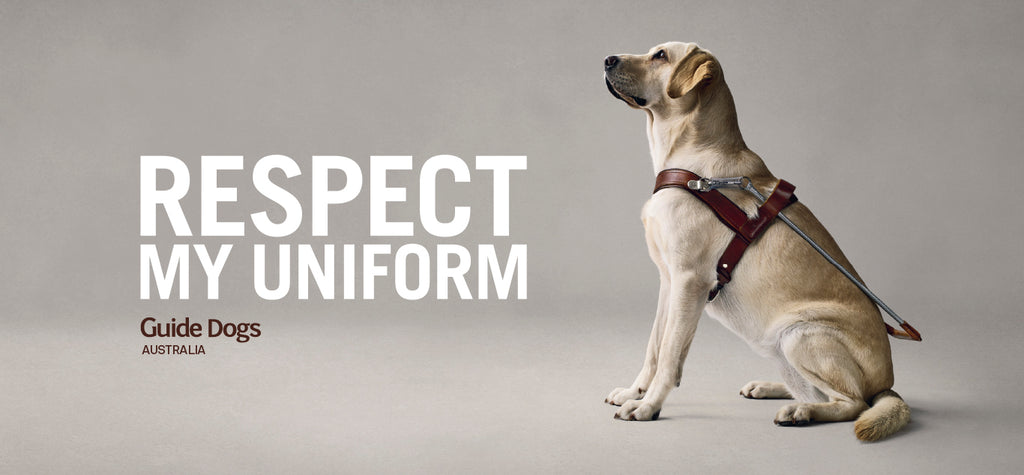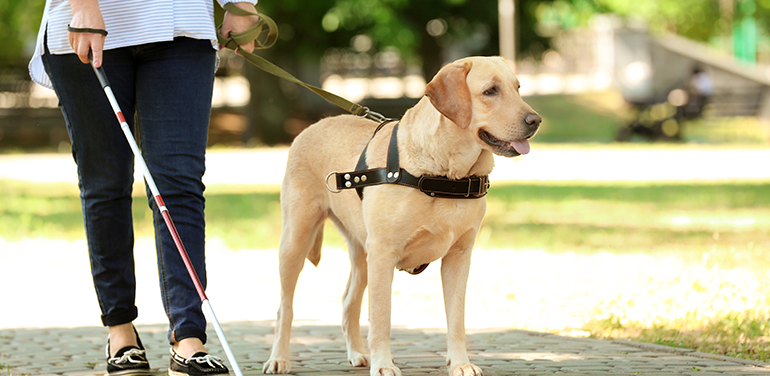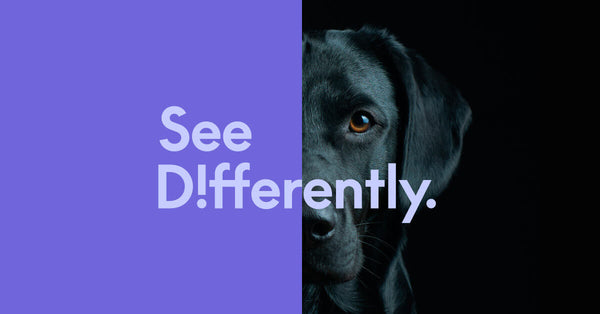AFTERPAY NOW AVAILABLE | CHRISTMAS SALES 30% OFF STORE WIDE - CODE "XMAS30"
AFTERPAY NOW AVAILABLE | CHRISTMAS SALES 30% OFF STORE WIDE - CODE "XMAS30"

If you think dogs can’t get any more adorable and loyal, you must not have met a guide dog in action yet.
With their leash and harness on and critical thinking, this special type of service or assistance dog will surely capture your heart, as they support people with visual impairment, such as blindness and low vision.
You might be wondering, how’s that possible? Aren’t dogs too playful for that crucial role? Believe it or not, the history of dogs leading blind people goes as far back as the Middle Ages. However, the first organised effort to train dogs to assist the visually impaired started around 1780 at the 'Les Quinze-Vingts blind hospital.
Today, the International Guide Dog Federation (IGDF) has already deployed over 20,000 guide dogs and established partnerships with 98 organisations across 34 different countries, including the Land Down Under.

If you want to know more about these fur babies with a noble mission, read on and be ready to fall even more for guide dogs Australia!
Did you know that the first guide dog in Australia was named Dreana?
Dreana, a black labrador retriever, became the cherished companion of Dr. Arnold Cook, a blind Economics Professor at the University of Western Australia. After studying in England, he soon met Dreana. The two immediately formed a profound bond, convincing Dr. Cook to bring Dreana back to Western Australia in 1950.
In just a year of Dr. Cook and Dreana's arrival, the word had spread, leading to the formation of a WA branch of the Guide Dog Association. In 1951, Beau, a cross between a Border Collie and Kelpie, became the first Australia-trained dog for Mrs Elsie Mead.
By 1957, every Australian state had its own guide dog provider, and today, the presence of guide dogs in Australia continues to grow, as reflected by the following statistics:
But even with the increase of guide dogs, these are still not enough for the growing number of blind and low-vision individuals—a staggering 575,000 population in Australia alone. With this imbalance, only 5% of visually impaired individuals worldwide use guide dogs.

Many people are already familiar with the role guide dogs play through reading, media exposure, or personal observation. While we understand their ability to assist the blind with navigating stairs, curbs, and following commands, much remains to uncover about their development.
How are guide dogs chosen and trained?
Guide dogs are responsible for safely assisting individuals with visual impairments in their daily lives. Hence, the selection and training criteria for Guide Dog programs are rigorous, with some variations among facilities, but typically include:
Guide dogs start their training and socialisation as puppies and continue throughout their lives. Some organisations even run their own breeding programs to ensure a better success rate.
The influence of genetic and environmental factors on the suitability of dogs to become guide dogs was first officially documented by the Royal Guide Dogs for the Blind Association of Australia.
The association initially depended on public donations of adult dogs, but this only resulted in a 20% suitability rate. Hence, they started a breeding program that had a “puppy walking scheme” and largely consisted of Labrador and Golden Retriever populations—breeds known for their good temperament and lack of fearfulness.
Later on, factors like ambidexterity and chest whorl direction were also explored to optimise guide dog suitability, where ambidextrous dogs (64-68%) and dogs with counter-clockwise whorls (61%) were found to have higher success rates.
Guide dog training starts as early as eight weeks of age. By this time, puppies stay with“puppy raisers” or foster families, where they learn to socialise, become confident, walk on a leash, and other basic commands. It’s also clear to the raisers that they don’t own the puppy but only act as custodians for 12 months.
The organisation will fully support the puppy’s needs and visit every four to six weeks to check the pup’s progress and health. Puppy raisers will also be required to do the following:
If you want to be a puppy raiser, kindly connect with local guide dog organisations.
At 14-16 months old, puppies raised in foster homes will return to the centre for a two-week temperamental test, where instructors will test the puppies’ reaction to distractions and situations.
Puppies who fail the test still have a chance to be therapy or companion dogs or be rehomed to their puppy raiser or other qualified families in Australia. While the ones who pass the test will commence their five-month formal guide dog training. This training includes the following:
A study published in The Veterinary Journal studied the success rate of dogs entering a guide dog training program (GDTP) based on their laterality (motor, sensory, and structural).
It was found that the GDTP only had a 50% success rate. Those who failed faced the following problems:
Many mistake guide dogs to be GPS-like, and no, they don’t read traffic lights. But despite this limitation, guide dogs are trained to be good decision-makers, which means they can take cues from their handlers and look out for hazards.
Here are some specific services guide dogs do to aid visually impaired individuals:
All of these tasks require the handler to have a high level of trust in the guide dog's decision-making abilities. Therefore, if you encounter a working guide dog, no matter how adorable they may appear, please avoid petting or trying to get their attention, as this can disrupt their vital work.
But unfortunately, 43% of Australians believe it’s okay to speak to a guide dog. Clearly, there’s a need for awareness drives.

To understand guide dogs and their work better, here are interesting facts that might shed light on how guide dogs integrate into our society.
The Disability Discrimination Act 1992, amended in 2009, states that“all assistance dogs are guaranteed access to all public places in Australia.”These include shops, pubs, beaches, health facilities, and government offices.The only exceptions are commercial kitchens, certain zoo areas, and operating theatres.
Unfortunately, Vision Australia research found that 55% of their handlers and puppy trainers still get denied entry in various public places. Apart from ensuring your guide dog’s wearing its working harness, you can also show your Guide Dog Access Rights card to deal with these situations.
If you’re still persistently barred from the place despite stating your rights, you may issue a police complaint and seek legal advice, as this offence warrants penalties of up to $880 and additional civil action.
Research by Dr Lisa Tomkins observed 114 dogs under a guide dog training program in Sydney. She found through a test involving a ‘Kong’ with dog treats that 47% of the dogs were ambidextrous. Surprisingly, these dogs also had greater training success rates (64-68%) compared to their lefty counterparts (38%).
Guide dogs’ ability to think critically and decide whether a situation endangers their owners or not sets them apart from regular fur babies. If they perceive dangers their owners might have missed, they will refuse to obey an unsafe command.
Do guide dogs take breaks? Of course, they do!
Trained to understand their job's completion with harness removal, guide dogs then transform into regular pets, welcoming interaction and care from the handler and their family, much like any other dog.
So the next time you see a working guide dog, wait until its harness is off before initiating interactions to avoid confusing the hard-working dog and his handler.
With their noble work, guide dogs truly deserve a special day!
The International Guide Dog Day is celebrated every 26th of April, marking the establishment of IGDF in 1989. On this day, show appreciation to your reliable companion by visiting dog parks, wearing matching sets, giving dog treats, or anything that’ll make your guide dog feel special.
Do you have family members or friends needing a guide dog?
Make sure to do your research first as the process of getting a guide dog can be as stringent as the selection process and comes with great responsibility.
Here are various ways to get a guide dog:
If you plan to get a guide dog through organisations or make a referral for visually impaired loved ones, take note of the following factors and steps that must be taken, as some guide dog partnerships do not succeed. A James Cook University research found the success rate for handlers and their initial guide dog partnerships is 84%.
Guide Dog Matching Considerations:
Application Steps:
Although breeding, raising, and training guide dogs take about 2 years and costs about $30,000, organisations like Guide Dogs Australia and Vision Australia provide qualified individuals with guide dogs forFREE.
Typically, guide dogs partner with their handlers for eight to 10 years. After living a dedicated working life, guide dogs will retire as beloved pets who get to run in parks freely, flaunt bandanas and hair bows, and casually enjoy puppuccinos.
They can be kept by their handlers or rehomed to a loving family that can provide the lifestyle they’ve been used to.
With the help of guide dogs, crossing streets, moving around towns, and even doing daily chores have become significantly easier for the visually impaired community. But guide dog charities and organisations also need your help to thrive and continue their operations.
Based on the IDGF database, there are currently eight (8) recognised guide dog facilities in Australia. These are their guide dogs program stats and facts:

Guide Dogs Australia, in partnership with its state-based affiliates, provides crucial services to individuals of all age groups who experience blindness or visual impairment.
Their mission is to make Guide Dogs accessible to everyone, regardless of their financial status. Services are provided to all, with the choice to use government funding when applicable, and for those ineligible, they offer free services supported by philanthropic donations
Six out of the eight guide dog providers in Australia are operated by the Guide Dogs movement in the following states:
You can support their cause by donating through your local Guide Dog centres or become a puppy raiser yourself!

With an extensive 140-year history of serving individuals with visual impairments, RSB, also known as See Differently, has been one of Australia’s leading not-for-profit providers of low vision services, including Guide and Assistance Dogs.
Apart from guide dog training programs, they’ve also offer the following:
Help RSB pursue its mission bydonating through its webpage orvolunteering in its activities.

Since 1960, Vision Australia division, has stood out for its personalised care and client-focused approach. It also maintains its mission of improving the independence and mobility of blind and low-vision individuals across Australia through Seeing Eye Dogs, training, and rehabilitation services.
If you want to support their vision orapply for a Seeing Eye Dog, you may reach them at 1800 422 007.
By donating and volunteering to these foundations, Australia can keep providing vision to the blind and low-vision community through angels with paws—dogs!